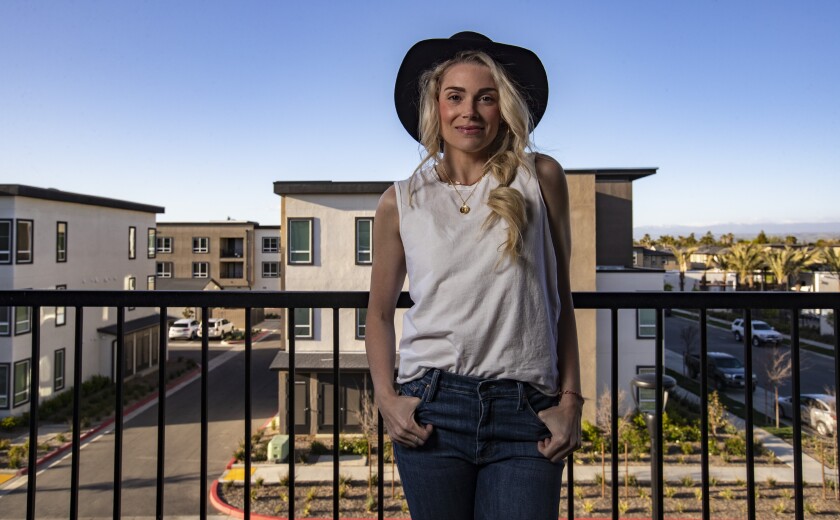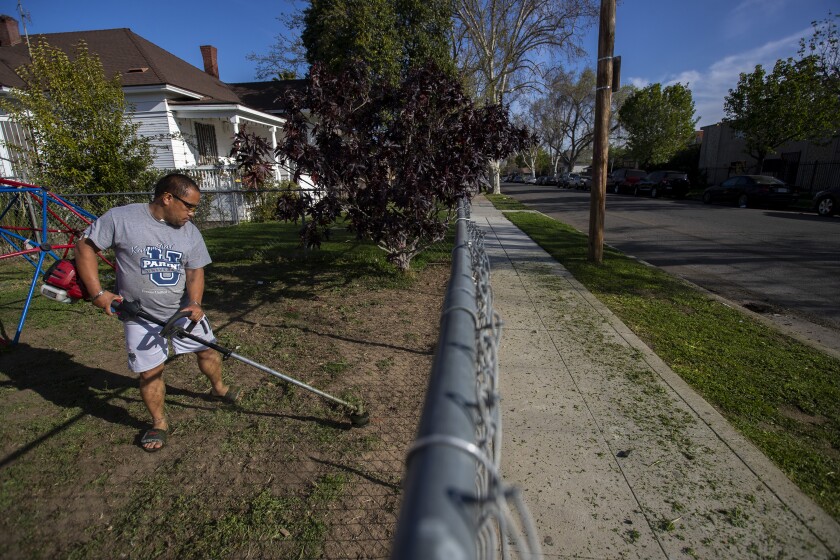After five years of planning and months of construction delays, first-time developer Vincent Ricchiuti was ready to open his luxury apartment complex. Then came the pandemic.
“We thought it was the worst time you could imagine,” Ricchiuti said about the grand opening in spring 2020.
Turns out he didn’t need to worry. His project, the Row, was opening in the nation’s hottest housing market: Fresno.
Within months, Ricchiuti had rented all 255 of the Row’s apartments and townhomes, even though its one-bedrooms go for as much as $2,600 a month — a price rivaling those in Los Angeles beach communities.
“We opened, and all of a sudden, here came the masses,” he said.
Over the last four years, no large U.S. city has seen greater increases in rent than Fresno. California’s fifth-biggest city, it’s an agricultural powerhouse on the doorstep of Yosemite National Park but often is thought of as a highway rest stop midway between Los Angeles and the Bay Area. Because of its pollution and poverty, Fresno makes regular appearances on lists of America’s worst places to live.
Yet since 2017, average rent for homes in Fresno is up nearly 39% to $1,289 a month, according to real estate firm Apartment List. That includes a 12% increase during the pandemic, the opposite of what has occurred in Los Angeles, San Jose and San Francisco, where rents have plummeted.
While Fresno’s costs have soared, they’re still low enough to provide a respite for people moving from pricier locales. But they have become a crushing burden to the region’s tens of thousands of low-income families.

A mural in downtown Fresno.
(Brian van der Brug / Los Angeles Times)
Even though the Central Valley is one of the country’s most agriculturally rich areas, it’s one of California’s poorest. Fresno’s median household income is $58,000 — nearly 30% below the state average.
Many blue-collar and service workers and farmworkers who lost their jobs amid the pandemic are facing possible eviction and feel trapped in substandard homes because higher costs elsewhere make it impossible for them to leave.
“I don’t know if I’ll have next month’s rent. I’m just trying to pay all the other bills,” said Denise Sandoval, 55, who hasn’t worked in a year and pays $725 a month for a two-bedroom apartment in northeast Fresno. “The management here, they know that I’m not employed. I’m just so scared to get behind.”
The reasons behind the increase in rent in Fresno are complex.
Unlike San Francisco — where the dramatic drop in rent is explained by the tens of thousands of people who left the city during the pandemic for more affordable and less crowded places — Fresno’s prices continued to swell even though more people left the city in 2020 than moved in, according to change-of-address information from the United States Postal Service and credit reporting data analyzed by the nonprofit California Policy Lab.
Local politicians and housing advocates say the situation is the result of gaps and failures in the city’s housing market that have built up over decades and have yet to be reformed after the mortgage foreclosure crisis nearly 15 years ago.
Construction of homes in Fresno nearly screeched to a halt after the Great Recession and remains stalled, even though, before the pandemic, the region was growing faster than others in the state, fueled in part by a booming healthcare sector. The average home value in Fresno is now nearly $300,000, according to real estate firm Zillow, having risen almost as fast as rents over the last four years.
The result is that rental housing for tenants at all income levels is in extremely short supply, with available apartments at record lows, according to data from real estate firm CoStar. And the ability to charge higher rents has increased speculation from investors looking to squeeze returns from newly purchased older properties.
For as long as she can remember, former Mayor Ashley Swearengin said, Fresno’s political leaders had been lulled into believing that as long as a small cadre of developers was building single-family-home subdivisions on the city’s fringes, the housing situation was fine.
“We had been engaged in this ‘cotton candy’ kind of economy, that swinging a hammer and building on our periphery was meeting our needs,” said Swearengin, who is now president and chief executive of the Central Valley Community Foundation. “The Great Recession was a wake-up call that it wasn’t. It was glaringly obvious that we were bringing the wrong tools to this issue, and we needed to change.”

Tera Whipple, a tenant at Fresno apartment development the Row, where her balcony has views of the Sierra Nevada.
(Brian van der Brug / Los Angeles Times)
The Row is one version of that change.
Ricchiuti’s family — longtime farmers in the region, with olive groves and almond trees — used to sell their agricultural holdings to builders of single-family homes. But Ricchiuti, 37, partnered with another family of farmers to develop the Row themselves on their land in Fresno’s affluent northern area. He hired market researchers, who said that residents — including aging baby boomers looking to downsize, young families waiting for new homes to be built and young, single professionals — were aching for high-end apartments.
Ricchiuti used Italianate white stone for the complex’s clubhouse, centered the development on a large pool with private cabanas and planted elm and olive trees to line the streets. On a clear day from the property, you can see the tops of the Sierra Nevada, an hour away.
“Finding people who can afford it, that’s not been the problem,” Ricchiuti said.
Five years ago, Linda Moreno moved to Fresno from a suburb of Washington, D.C., with her husband, a government auditor, and their two children to be close to her husband’s ailing mother. While looking for places to live, she was stunned at what she could afford.
“We were the poor of Bethesda, and now we’re the rich of Fresno,” said Moreno, 54.
The family started out by renting single-family homes but last October signed an 18-month lease for a three-bedroom townhome at the Row, for just over $2,300 a month. Moreno is happy she locked down the home. Because of the high demand, the same units are being advertised now for as much as $3,400 a month.
The family could buy something in Fresno but is wary of putting down roots in a place known for droughts.

Linda Moreno, 54, who lives at the Row with her family, in the complex’s community room.
(Brian van der Brug / Los Angeles Times)
For others, renting is the only option. While prices in the region remain far below those in other areas of the state — median one-bedroom rentals in San Francisco average $1,000 more a month than in Fresno — the housing affordability challenges here are worse by some metrics.
A greater percentage of families in Fresno spend more than half their income on rent than those in San Francisco or Los Angeles. The housing shortage for low-income households in Fresno tops 35,000 units, according to advocacy group California Housing Partnership Corp.

Pao Vang trims the grass at a home he rents in the Lowell neighborhood in Fresno.
(Brian van der Brug / Los Angeles Times)
Now the twin pains of the pandemic and rising rents have put more of a squeeze on Fresno’s most vulnerable.
Blanca, a 34-year-old who lives with her husband and three children, has seen her rent increase every six months, including during the pandemic. For her three-bedroom home in southeast Fresno, Blanca — who declined to give her full name out of fear of retaliation — pays $945 a month, 40% more than when she moved in a decade ago.
Her husband has lost work in a packing plant over the last year. She said her landlord took two years to fix their leaky roof and is ignoring her requests to replace ratty carpeting. Newly pregnant, she’s afraid of getting evicted but also believes the home’s deteriorating condition makes it too dangerous to be there.
“I want to leave,” Blanca said. “I can’t live like this anymore. I’m looking, but I haven’t found anything. The cost is too high.”

A park in downtown Fresno.
(Brian van der Brug / Los Angeles Times)
Fresno activists say Blanca’s story is common among low-income tenants, with families regularly reporting rent hikes of 10% or more in recent years.
“They’re at a point where they’re having to decide whether they can afford a home that’s healthy, sanitary and in a livable condition, or whether they have to move,” said Grecia Elenes, regional policy manager at the Leadership Counsel for Justice & Accountability, a Central Valley advocacy group.
Driving some of the price increases in Fresno’s poorer southern neighborhoods are investors who pay skyrocketing prices for aging four- to 10-unit apartment complexes, said Brad Hardie, president of Regency Property Management, which manages 8,000 homes across the Central Valley. These new landlords are boosting rents by as much as 10%, Hardie said, which signals to neighboring property owners that they can do the same.
“I see it every day. It’s mind-blowing,” Hardie said.
Some tenants have weathered the rent hikes during the pandemic by moving in together or receiving expanded unemployment benefits and other government assistance, Hardie said. He fears what may happen when the money goes away and jobs don’t immediately return.

Denise Sandoval, 55, lost her job at the beginning of the pandemic and is worried about falling behind on rent.
(Brian van der Brug / Los Angeles Times)
For Sandoval, who lost her job nearly a year ago, that moment has arrived.
The lifelong Fresno resident left her customer service position at a propane sales company in January 2020 to take care of her sick mother. She returned in April but was laid off a couple of weeks later.
Now Sandoval is afraid she won’t be able to find work that could pay anything close to what she was making before. She’s getting groceries from local food banks and is current on her rent only because she qualified for three months of rental assistance from one of the federal coronavirus relief packages. Her unemployment assistance just ran out; she’s in the process of reapplying to receive more benefits.
“It’s definitely harder for people at the bottom,” she said. “Not everybody can move into the new building with the granite countertops and the washer-dryer. In the real world, who can do that?”
Sandoval’s rent hasn’t increased during the pandemic. But when she looks at her complex’s Facebook page, she sees an apartment similar to hers advertised for $200 more a month. It’s only a matter of time, she believes, before her bill goes up.
